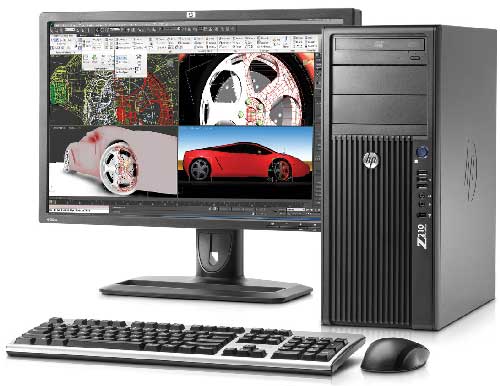HP Z210 Workstation: Solid Performance at a Great Price
HP's updated entry-level CAD workstation delivers great value and solid performance.
Latest News
December 4, 2001
By David Cohn
 The HP Z210 marks the entry-level point in the company’s Z-series workstation line. Targeted at mainstream CAD users, prices start at $569—making it one of the most affordable independent software vendor (ISV)-certified systems.
The HP Z210 marks the entry-level point in the company’s Z-series workstation line. Targeted at mainstream CAD users, prices start at $569—making it one of the most affordable independent software vendor (ISV)-certified systems.
The HPZ210 we received looked similar to its predecessor. The front panel has three exposed 5.25-in. drive bays. The topmost bay contains a tray-loading 16X SATA dual-layer SuperMulti LightScript DVD+/-RW optical drive, while the lower bay houses a 22-in-1 media card reader. These bays can be rotated 90° to convert from a mini-tower to a desktop configuration, and a Blu-ray Disc writer is an option.
Below these bays, vertical fins conceal the air intake and internal speaker while a power button, three USB ports, headphone and microphone jacks, and an IEEE 1394a FireWire connector occupy a narrow vertical panel down the right side. The other ports mentioned in the info box below are found on the rear panel.
Lots of Expansion Options
Removing the left-side panel on the tool-less chassis reveals a well-organized interior. Below the external drive bays are three 3.5-in. internal drive bays, one of which contained a Samsung 1TB 7,200 rpm SATA drive. Drives of up to 2TB are available, and HP also offers solid state drives ranging from 128 to 300GB.
CPU options for the Z210 range from a 2.6GHz Intel Pentium processor to various Core i3, i5 and i7 processors—and all the way to the 3.6GHz Intel Xeon E3-1290 processor. Our evaluation unit came with a 3.36GHz Intel Xeon E3-1245 quad-core CPU with an 8MB Smart Cache mounted in the single CPU socket. The processor supports HyperThreading and also includes Intel HD Graphics’ P3000 integrated graphics.
| Click here to see the benchmark results. |
Our system included 8GB of 1333MHz DDR3 ECC memory, installed as four 2GB dual in-line memory modules (DIMMs). But using two 4GB DIMMs would only add $40 to the overall cost, if you contemplate adding more memory in the future. The Z210 supports up to 32GB of RAM. Power was provided via a 400-watt, 90% efficient power supply.
The motherboard includes seven expansion slots: two PCIe2 x16 graphics slots, one PCIe2 x8 slot, two PCIe2 x1 slots, and two full-length PCI slots. One of the graphic slots was filled with an NVIDIA Quadro 2000 graphics accelerator with 1GB of dedicated GDDR5 memory.
The two PCIe2 x1 slots were also filled: one contained a FireWire IEEE 1394a card, and the other a USB 3.0 host controller with a pair of additional USB 3.0 ports. There are also five more internal USB ports available. Despite fans on the graphics card, CPU, power supply and rear panel, the Z210 was nearly silent.
A Price/Performance Leader
The Intel Xeon E3-1245 is a pretty fast quad-core processor, and the Quadro 2000 is one of NVIDIA’s more powerful graphics accelerators, so we were prepared for some pretty good performance. The system turned in the best SPECviewperf performance we’ve recorded to date for a system equipped with a single CPU running at its standard processor speed.
We also repeated the SPECviewperf test using just the integrated Intel graphics. While the Intel HD P3000 graphics alone is certainly capable of running most CAD applications, its performance was, on average, 77% slower than that of the NVIDIA graphics accelerator.
On the SPECapc SolidWorks benchmark, which is more of a real-world test (and breaks out graphics, CPU and I/O performance separately from the overall score), the results for the Z210 equipped with the Quadro 2000 were also excellent.
The AutoCAD rendering test results also ranked among the fastest we’ve recorded for a system with a non-over-clocked CPU. Because AutoCAD’s Mental Ray rendering engine is multi-threaded, this test shows the benefits of multiple cores: The Z210 averaged 62 seconds to complete the rendering test.
The Z210 starts at $659, but that gets you just 2GB of memory, a smaller hard drive, and integrated Intel HD Graphics 2000. The small form factor (SFF) version starts even lower, at just $569, but its expansion options are a bit more limited.
While adding options can certainly boost the price considerably, even as tested our HP Z210 evaluation unit cost just $2,836. To sweeten the deal, HP is currently offering a 20% discount, bringing the price down to $2,269.
David Cohn is the technical publishing manager at 4D Technologies. He also does consulting and technical writing from Bellingham, WA, and has been benchmarking PCs since 1984. He’s a contributing editor to Desktop Engineering and the author of more than a dozen books. Contact him via email at [email protected] or visit DScohn.com.
MORE INFO
Subscribe to our FREE magazine, FREE email newsletters or both!
Latest News
About the Author
David Cohn is a consultant and technical writer based in Bellingham, WA, and has been benchmarking PCs since 1984. He is a Contributing Editor to Digital Engineering, the former senior content manager at 4D Technologies, and the author of more than a dozen books. Email at [email protected] or visit his website at www.dscohn.com.
Follow DE





